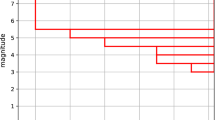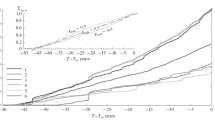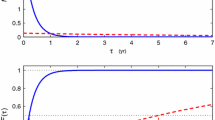Abstract
A modified formula of the cumulative frequency-magnitude relation has been formulated and tested in a previous paper by the authors of this study.
Based on the modified relationship, the following reoccurrence formulas have been obtained.
-
1)
For the ‘T-years period’ larger earthquake magnitude,M T
$$M_T = \frac{1}{{A_3 }}ln\frac{{A_2 }}{{(1/T) + A_1 }}.$$ -
2)
For the value of the maximum earthquake magnitude, which is exceeded with probabilityP inT-years period,M PT
$$M_{PT} = \frac{{ln(A_2 .T)}}{{A_3 }} - \frac{{ln[A_1 .T - ln(1 - P)]}}{{A_3 }}.$$ -
3)
For the probability of occurrence of an earthquake of magnitudeM in aT-years period,P MT
$$P_{MT} = 1 - \exp [ - T[ - A_1 + A_2 \exp ( - A_3 M)]].$$
The above formulas provide estimates of the probability of reoccurrence of the largest earthquake events which are significantly more realistic than those based on the Gutenberg-Richter relationships; at least for numerous tested earthquake samples from the major area of Greece.
Similar content being viewed by others
References
Drakopoulos, J. andMakropoulos, C. (1983),Seismicity and hazard analysis studies in the area of Greece. (Seism. Lab. Athens Univ., Publ. no. 1,) pp. 1–126.
Epstein, B. andLomnitz, C. (1966).A model for the occurrence of large earthquakes, Nature211, 954–956.
Gumbel, E. J. (1966),Statistics of Extremes. (Columbia Univ. Press, New York), 375 pp.
Gutenberg, B. andRichter, C. F. (1944),Frequency of earthquakes in California, Bull. Seism. Soc. Am.24, 185–188.
Latousakis, J. (1985),Proposal for a modification of the cumulative frequency-magnitude relationship, Ph.D. Thesis, Athens University, pp. 1–167.
Latousakis, J. andDrakopoulos, J. (1987),A modified formula for frequency-magnitude distribution, PAGEOPH125, this issue.
Makropoulos, C. (1978),The statistics of large earthquake magnitude and an evaluation of Greek seismicity, Ph.D. Thesis, University of Edinburgh, pp. 1–178.
Makropoulos, K., Drakopoulos, J. andLatousakis, J. (1986),A revised earthquake catalogue for Greece since 1900. (Geoph. Dep. of Athens Univ., Publ. no. 2), pp. 1–94.
Papazachos, B. C. andComninakis, P. E. (1982),A catalogue of historical earthquakes in Greece and the surrounding area. (Geoph. Lab. Thessaloniki Univ., Publ. no. 5,) pp. 1–71.
Author information
Authors and Affiliations
Rights and permissions
About this article
Cite this article
Latousakis, J., Drakopoulos, J. Reoccurrence formulas for the largest earthquake magnitudes based on the modified cumulative frequency-magnitude relationship. PAGEOPH 125, 765–775 (1987). https://doi.org/10.1007/BF00878032
Received:
Revised:
Accepted:
Issue Date:
DOI: https://doi.org/10.1007/BF00878032




